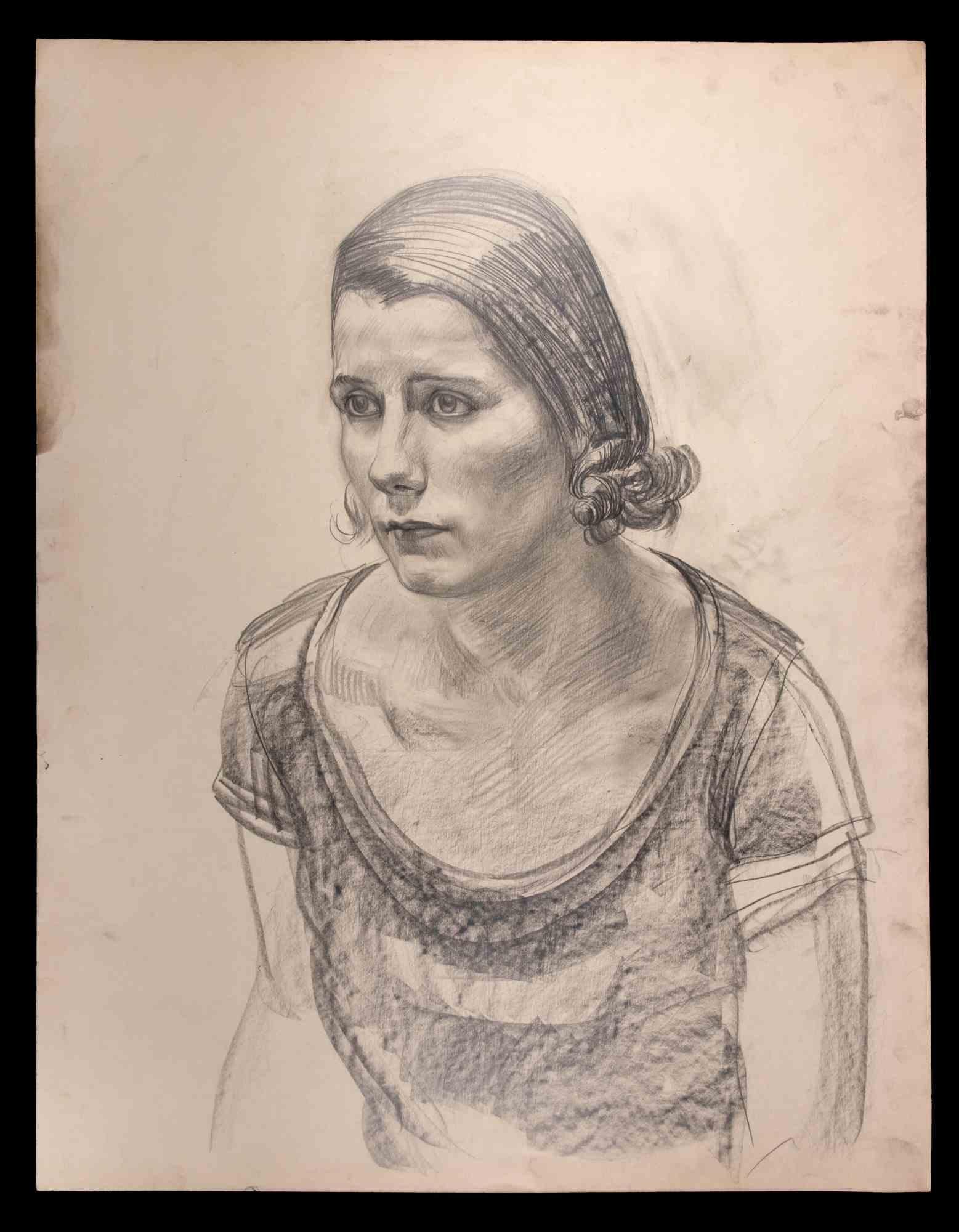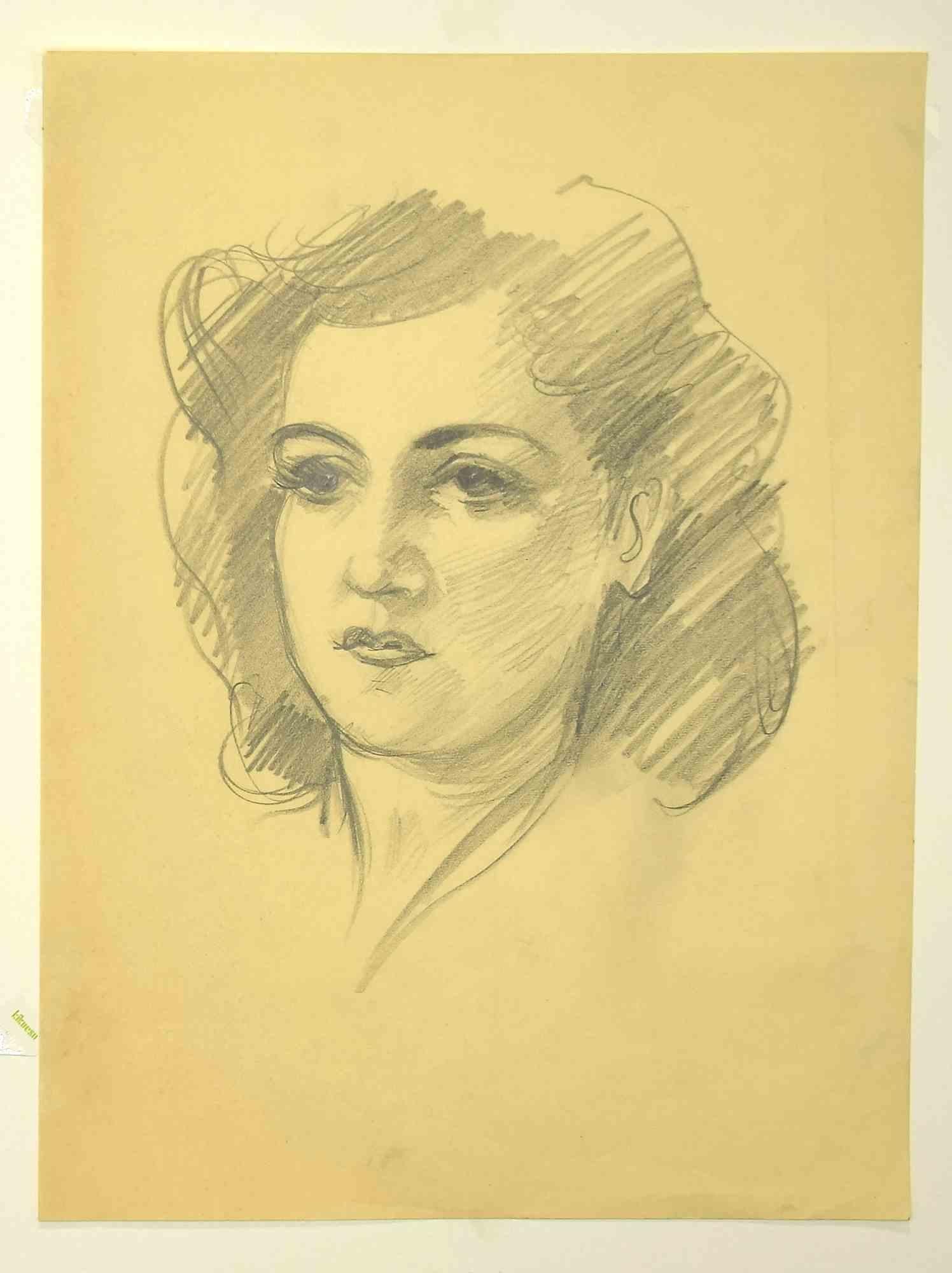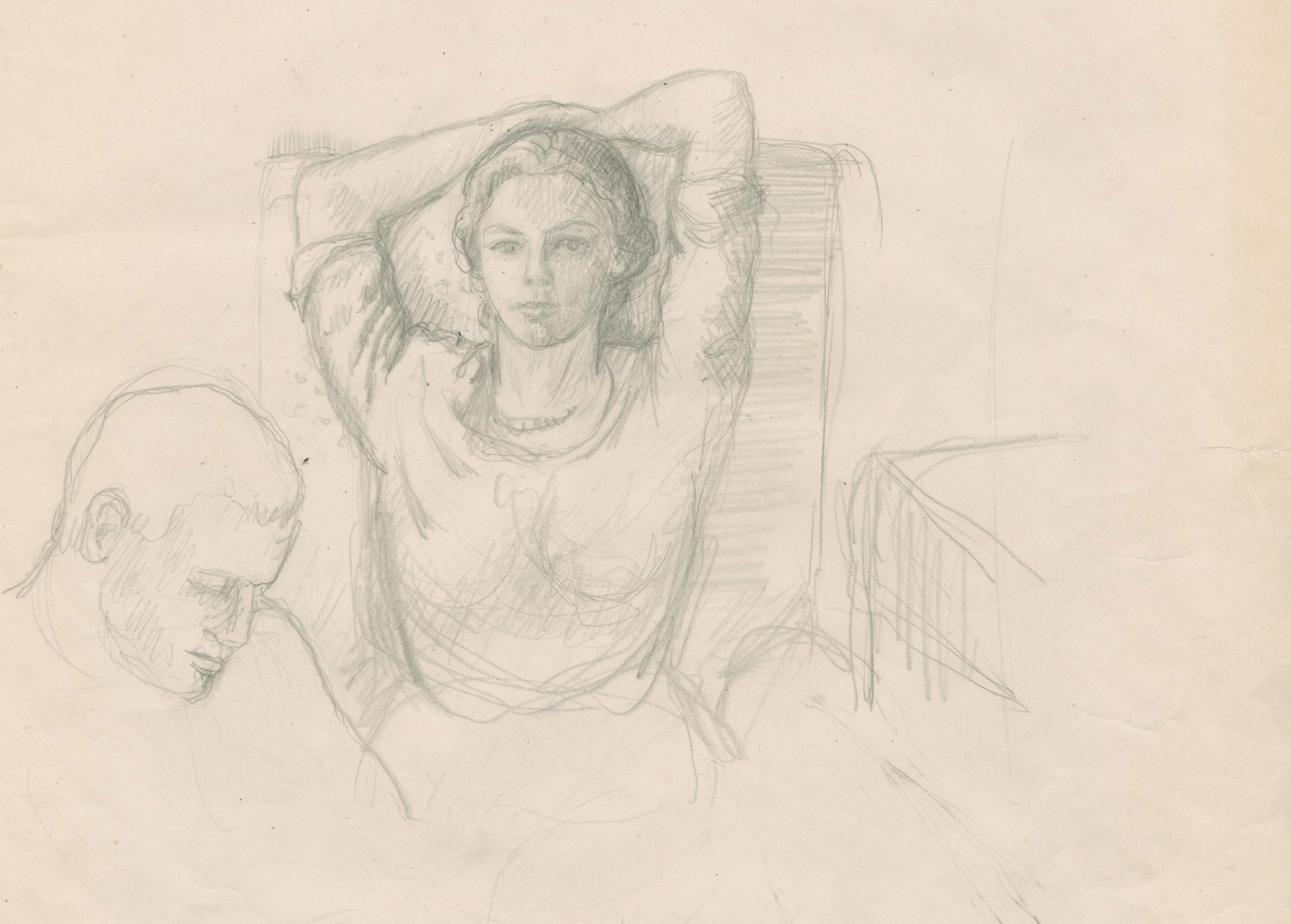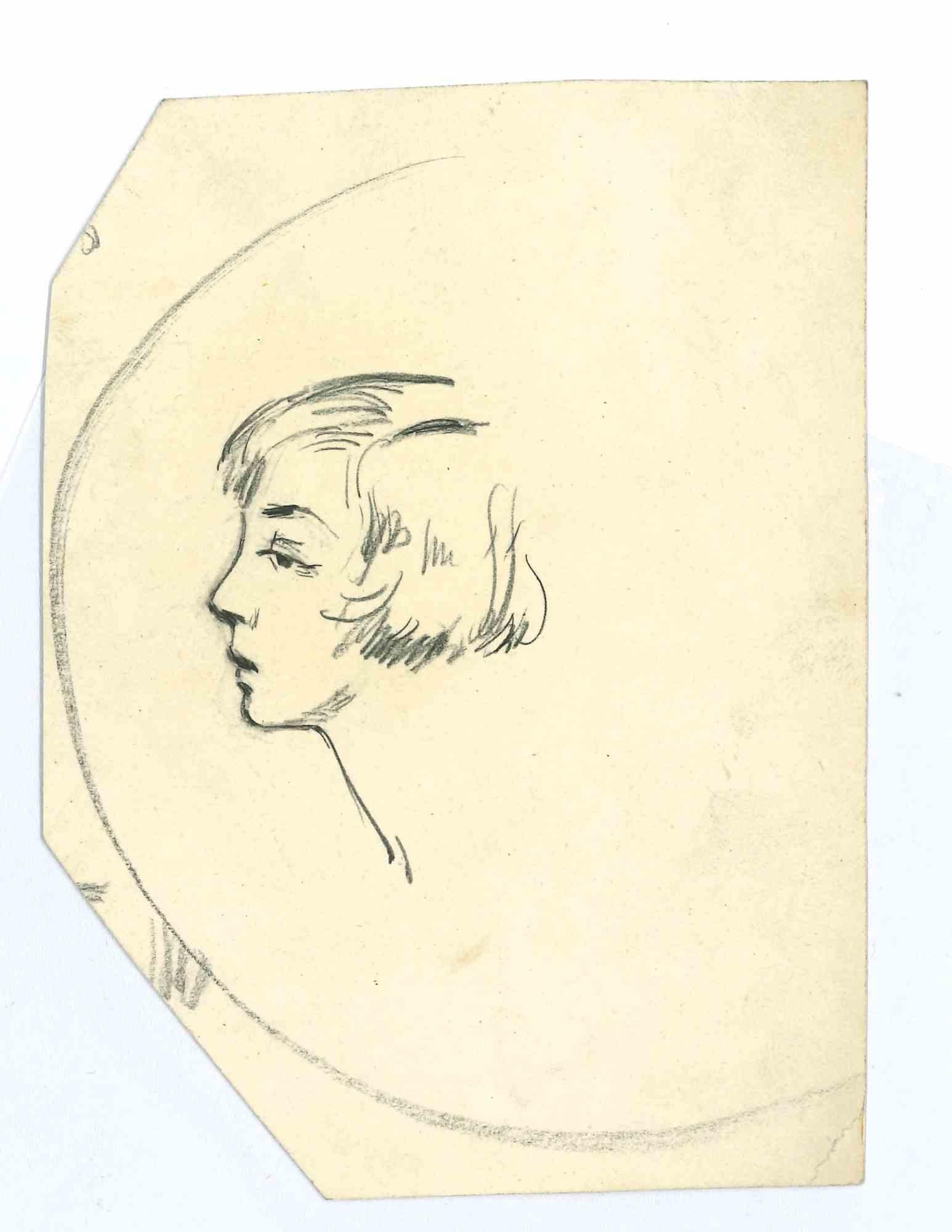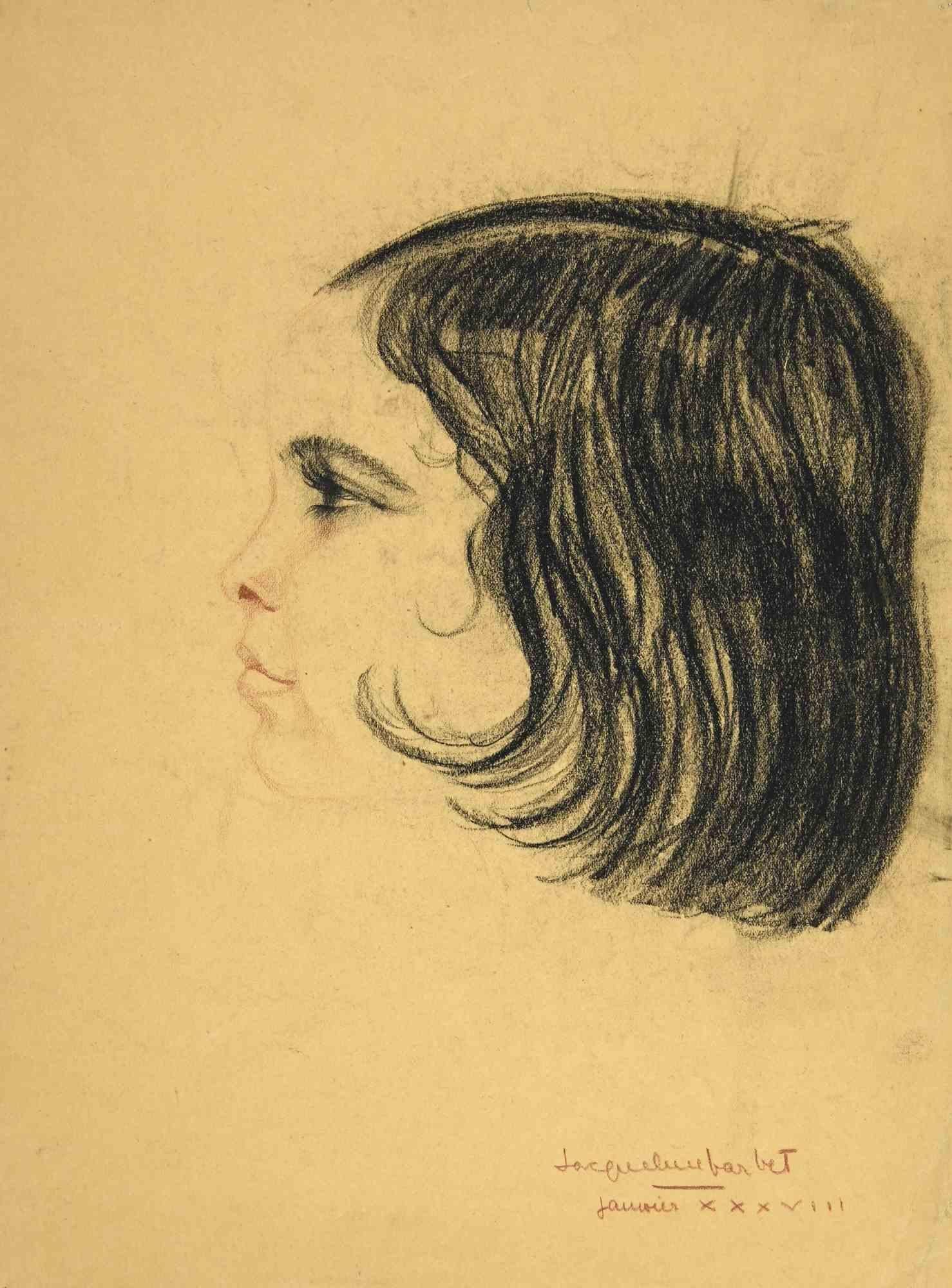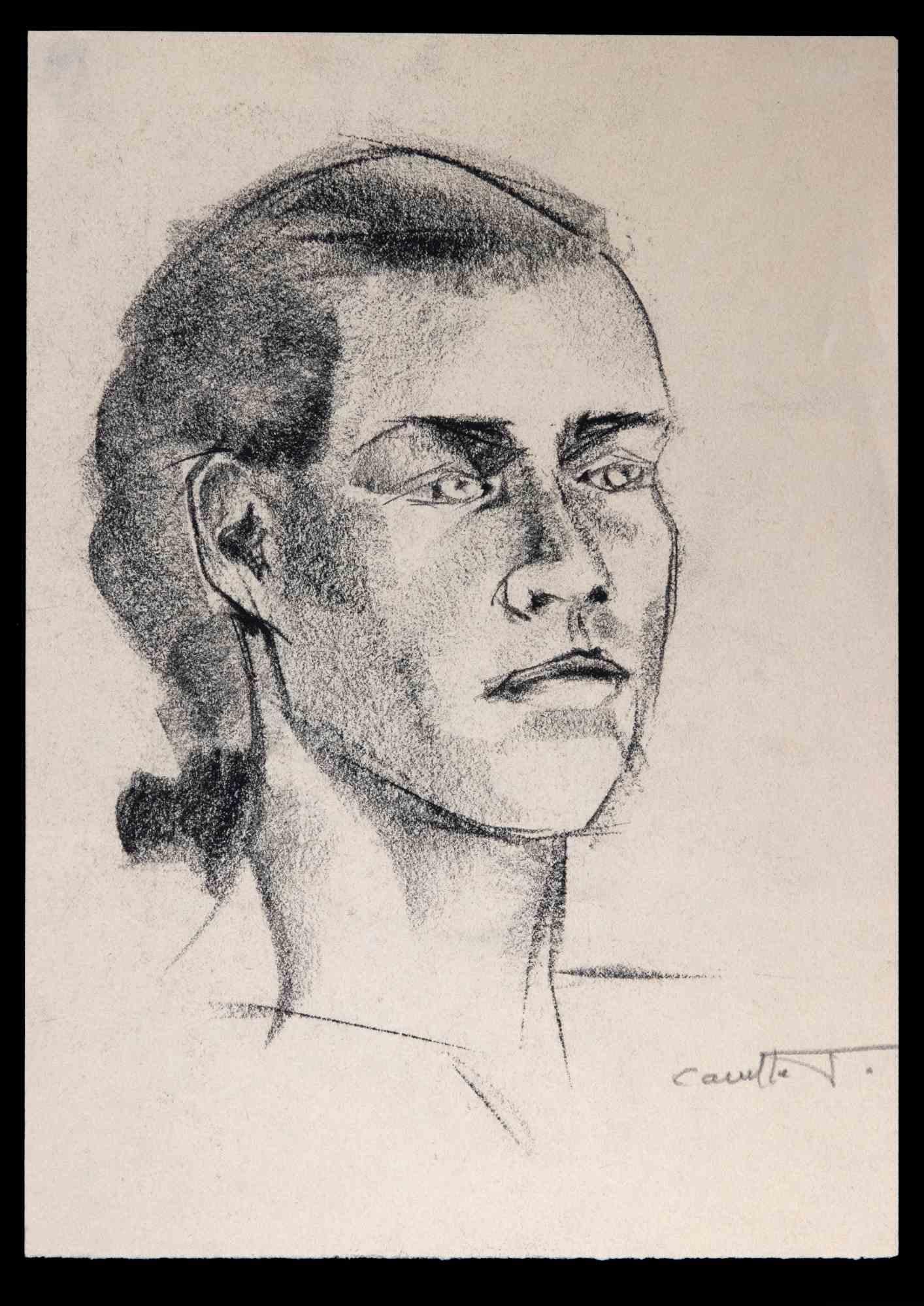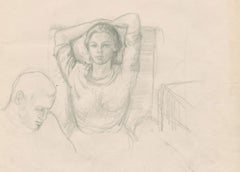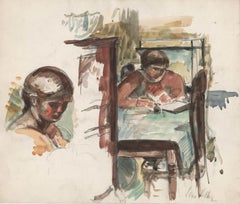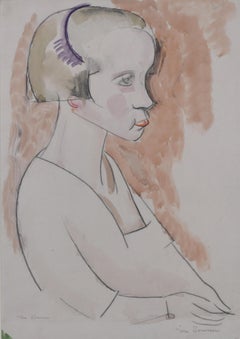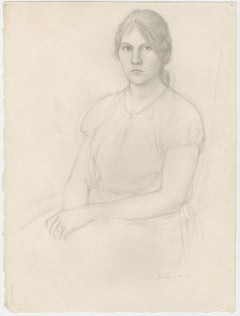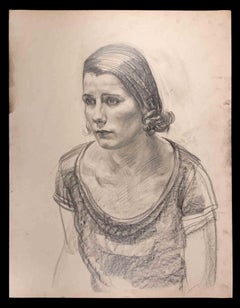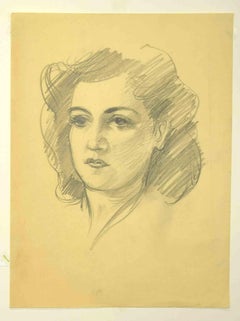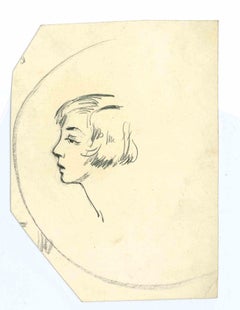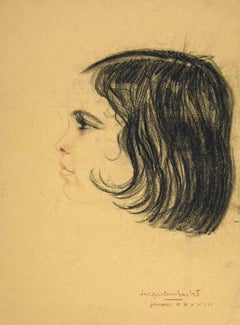Items Similar to Self Portrait sketching with Vignette in Profile
Want more images or videos?
Request additional images or videos from the seller
1 of 9
Margarete Hoening FrenchSelf Portrait sketching with Vignette in Profile1940's
1940's
$1,250
£942.62
€1,090.19
CA$1,753.74
A$1,949.39
CHF 1,021.83
MX$23,806.83
NOK 12,756.97
SEK 12,001.93
DKK 8,136.86
About the Item
Self Portrait sketching with Vignette in Profile
Graphite on thin wove paper, c. 1940's
Unsigned
Condition: Small nicks in the right margin, not affecting the image
Sheet size: 14 1/2 x 10 inches
Provenance: Paul Cadmus
Jon F. Anderson (1937-2018)
Born in Hoboken, New Jersey, Margaret Hoening (1906–1998) was a painter and an etcher perhaps best known for her
photographs as part of the PaJaMa photography collective. After attending Smith College, she settled in New York, where
she pursued formal artistic training at the Art Students League. There, she met the artist couple Paul Cadmus and Jared
French. In 1937, she married French, fifteen years her junior, who had spent the previous decade with Cadmus. The trio
formed a tight bond, with Cadmus and French continuing their relationship.
Born in Hoboken, New Jersey, Margaret Hoening (1906–1998) was a painter and an etcher perhaps best known for her
photographs as part of the PaJaMa photography collective. After attending Smith College, she settled in New York, where
she pursued formal artistic training at the Art Students League. There, she met the artist couple Paul Cadmus and Jared
French. In 1937, she married French, fifteen years her junior, who had spent the previous decade with Cadmus. The trio
formed a tight bond, with Cadmus and French continuing their relationship. Together, the three formed PaJaMa (a mashup of their first names, Paul, Jared, and Margaret). Using Hoening’s Leica, they captured themselves, their artist friends,
and members of the gay community posing in artful tableaux on the beaches of Fire Island, Provincetown, and Nantucket
over the following eight years. Those captured by their camera include the photographer George Platt Lynes; Cadmus’s
sister and artist Fidelma; artist Bernard Perlin; and Monroe Wheeler, director of exhibitions at the Museum of Modern Art,
among others. Though she produced few canvases, Hoening’s paintings demonstrate the influences of French and Cadmus,
particularly with her adoption of the time-intensive, traditional medium of egg tempera that they championed.
In the 1940s, the Frenches’ social circle continued to expand. They befriended the British author E.M. Forster, who stayed
with them on his first trip to New York in 1947, spending a few days with them in Provincetown, and visiting them again
in 1949. When Cadmus began a relationship with the young artist George Tooker in 1944, the trio became a foursome,
with Tooker regularly vacationing with the group and appearing in PaJaMa’s photographs. But it was during a vacation
through Italy and France in 1949 that Tooker broke away from Cadmus because of the latter’s relationship with the Frenches.
Throughout the 1940s and 1950s, the pair traveled extensively throughout Europe with Cadmus nearly always accompanying
them. Jared eventually moved to Italy to pursue a relationship with Roberto Giannotta, and Hoening followed.
Cuortesy David Zwirner
- Creator:Margarete Hoening French (1906 - 1998, American)
- Creation Year:1940's
- Dimensions:Height: 14.5 in (36.83 cm)Width: 10 in (25.4 cm)
- Medium:
- Movement & Style:
- Period:
- Condition:
- Gallery Location:Fairlawn, OH
- Reference Number:Seller: FA116611stDibs: LU14015438012
About the Seller
5.0
Recognized Seller
These prestigious sellers are industry leaders and represent the highest echelon for item quality and design.
Platinum Seller
Premium sellers with a 4.7+ rating and 24-hour response times
Established in 1978
1stDibs seller since 2013
808 sales on 1stDibs
Typical response time: <1 hour
Associations
International Fine Print Dealers Association
- ShippingRetrieving quote...Shipping from: Akron, OH
- Return Policy
Authenticity Guarantee
In the unlikely event there’s an issue with an item’s authenticity, contact us within 1 year for a full refund. DetailsMoney-Back Guarantee
If your item is not as described, is damaged in transit, or does not arrive, contact us within 7 days for a full refund. Details24-Hour Cancellation
You have a 24-hour grace period in which to reconsider your purchase, with no questions asked.Vetted Professional Sellers
Our world-class sellers must adhere to strict standards for service and quality, maintaining the integrity of our listings.Price-Match Guarantee
If you find that a seller listed the same item for a lower price elsewhere, we’ll match it.Trusted Global Delivery
Our best-in-class carrier network provides specialized shipping options worldwide, including custom delivery.More From This Seller
View AllSelf Portrait with Arms Over Head, vignette on Paul Cadmus on left
Located in Fairlawn, OH
Self Portrait with Arms Over Head, vignette on Paul Cadmus on left
Graphite drawing on thin wove paper, c. 1940's
Unsigned
Provenance: Paull Cadmus
Jon F. Anderson (1937-2018)
Condition:
Sheet size: 15 x 10 1/4 inches
Born in Hoboken, New Jersey, Margaret Hoening (1906–1998) was a painter and an etcher perhaps best known for her
photographs as part of the PaJaMa photography collective. After attending Smith College, she settled in New York, where
she pursued formal artistic training at the Art Students League. There, she met the artist couple Paul Cadmus and Jared
French. In 1937, she married French, fifteen years her junior, who had spent the previous decade with Cadmus. The trio
formed a tight bond, with Cadmus and French continuing their relationship.
Born in Hoboken, New Jersey, Margaret Hoening (1906–1998) was a painter and an etcher perhaps best known for her
photographs as part of the PaJaMa photography collective. After attending Smith College, she settled in New York, where
she pursued formal artistic training at the Art Students League. There, she met the artist couple Paul Cadmus and Jared
French. In 1937, she married French, fifteen years her junior, who had spent the previous decade with Cadmus. The trio
formed a tight bond, with Cadmus and French continuing their relationship. Together, the three formed PaJaMa (a mashup of their first names, Paul, Jared, and Margaret). Using Hoening’s Leica, they captured themselves, their artist friends,
and members of the gay community posing in artful tableaux on the beaches of Fire Island, Provincetown, and Nantucket
over the following eight years. Those captured by their camera include the photographer George Platt Lynes; Cadmus’s
sister and artist Fidelma; artist Bernard Perlin; and Monroe Wheeler, director of exhibitions at the Museum of Modern Art,
among others. Though she produced few canvases, Hoening’s paintings demonstrate the influences of French and Cadmus,
particularly with her adoption of the time-intensive, traditional medium of egg tempera that they championed.
In the 1940s, the Frenches’ social circle continued to expand. They befriended the British author E.M. Forster, who stayed
with them on his first trip to New York in 1947, spending a few days with them in Provincetown, and visiting them again
in 1949. When Cadmus began a relationship with the young artist George Tooker in 1944, the trio became a foursome,
with Tooker regularly vacationing with the group and appearing in PaJaMa’s photographs...
Category
1940s American Modern Portrait Drawings and Watercolors
Materials
Graphite
Two Studies of Henriette (Head of the artist's wife & The Artist's wife writing
By Leon Kelly
Located in Fairlawn, OH
Two Studies of Henriette (Left: Head of the artist's wife, Right: The Artist's wife writing a letter)
Watercolor and graphite on paper, 1928-1930
Signed in pencil lower right (see photo)
Image/sheet size: 9 3/8 x 11 inches
Condition: Excellent
Colors fresh and unfaded
Provenance: Estate of the artist
The Orange Chicken...
Category
1920s American Modern Figurative Drawings and Watercolors
Materials
Watercolor
Girl in Profile
By William Sommer
Located in Fairlawn, OH
Girl in Profile
Lithographic crayon and watercolor on thin wove paper, c. 1930
Signed twice in pencil (see photos)
Provenance: Estate of the Artist
Edward Somme...
Category
1930s American Modern Figurative Drawings and Watercolors
Materials
Watercolor
Untitled (Seated Young Woman)
Located in Fairlawn, OH
Untitled (Seated Young Woman)
Graphite on Veritable Papier d'Arches wove paper, 1970
Signed and dated lower right (see photo)
Condition: Excellent
Image/sheet size: 15 x 11 1/4 inch...
Category
1970s American Realist Figurative Drawings and Watercolors
Materials
Graphite
Head of a Woman (Margaret)
By Leon Kroll
Located in Fairlawn, OH
Head of a Woman (Margaret)
conte on wove paper, 1925
Signed and dated lower right
Annotated "Margaret" in ink verso
A portrait of Margaret Cassidy Manship ( d. 2012), daughter in law...
Category
1920s Ashcan School Figurative Drawings and Watercolors
Materials
Conté
Portrait of Gladys Anne Hoskyns
Located in Fairlawn, OH
Portrait of Gladys Anne Hoskyns
Collotype after a Wyndham Lewis drawing, 1923
Singed in the plate and reinforced in pencil
Published by The Dial Publishing Company in Living Art...
Category
1920s Modern Figurative Prints
Materials
Lithograph
You May Also Like
Portrait of Woman - Original Drawing - Mid-20th Century
Located in Roma, IT
Portrait of Woman is an original artwork, pencil, charcoal on paper. Is not signed and dated but we can attribute the period middle 20th Century.
The artist want to define a sensit...
Category
Mid-20th Century Modern Figurative Drawings and Watercolors
Materials
Mixed Media
Portrait of Woman - Drawing - Early 20th century
Located in Roma, IT
Portrait of Woman is a drawing realized in the early 20th century by an Anonymous French artist.
Pencil on paper.
The state of preservation is good.
The artwork is represented thr...
Category
Early 20th Century Modern Figurative Drawings and Watercolors
Materials
Pencil, Paper
The Profile of Woman - Original Drawing by Micheline Resco - Mid 20th Century
Located in Roma, IT
The Profile of Woman is an Original Drawing in pencil on creamy-colored paper realized by Micheline Resco in the mid-20th century.
Good conditions.
...
Category
Mid-20th Century Modern Figurative Drawings and Watercolors
Materials
Pencil
Portrait - Drawing by Jacqueline Barbet - 1938
By Jacqueline Barbet
Located in Roma, IT
Portrait is an artwork realized by the french Artist Jacqueline Barbet (1902-1975), in 1938.
Pencil, pastel and charcoal rawing on paper. Hand-signed and dated in pencil in Roman nu...
Category
1930s Modern Figurative Drawings and Watercolors
Materials
Pencil, Pastel, Charcoal
Portrait of a Woman - Original Drawing by Unknown - Mid 20th Century
Located in Roma, IT
Portrait of a Woman is an Original Charcoal Drawing realized by an unknown French Artist in the mid-20th Century.
The artwork is in good condition on a yellowed paper.
Hand-signed ...
Category
Mid-20th Century Modern Figurative Drawings and Watercolors
Materials
Pencil
Portrait - Drawing by Flor David - Mid 20th Century
By Flor David
Located in Roma, IT
Portrait is a drawing on paper realized in the Mid-20th Century by Flor David.
Pencil on Creamy-colored paper.
Good conditions.
Flor David (1891-1958) ): pseudonym of David Florence. Pastel painter. He was a pupil of Desirè Lucas...
Category
Mid-20th Century Modern Figurative Drawings and Watercolors
Materials
Pencil
More Ways To Browse
French Sketches
Self Portrait Drawing
1944 Portraits
1940s French Drawings
Fire Island
Gay Portrait
Fire Island Vintage
Gay Vintage Photographs
Nantucket Photography
1940s British Portraits
Egg Collective
George Platt Lynes
Platt Lynes
E Anderson
George Platt Lynes Photograph
Egg Jar
Oil Paintings Of Homes
Acrylic Nature Painting
